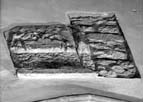Select a site alphabetically from the choices shown in the box below. Alternatively, browse sculptural examples using the Forward/Back buttons.
Chapters for this volume, along with copies of original in-text images, are available here.
Object type: Fragment, possibly an altar converted into a sundial
Measurements: Too high to measure, but observed by Taylor and Taylor (1963a, 17) that the dial had a radius of 6 inches (15 cm) and a hole for the gnomon 3 inches (7.5 cm) deep.
Stone type: Unobtainable
Plate numbers in printed volume: Pl. 447
Corpus volume reference: Vol 7 p. 215-6
(There may be more views or larger images available for this item. Click on the thumbnail image to view.)
This description is based partly on what was visible from below and partly on the Taylors' observations from scaffolding. The viewpoint of the photograph is inevitably distorting but it is difficult to reconcile what can be seen in the photograph and the published drawing. It must be remembered however that when the Taylors recorded these pieces they were primarily interested in the pilaster strip with stepped base which is in the wall alongside them (Taylor and Taylor 1963a, 16–17, fig.; Taylor and Taylor 1965, I, 182–4).
On the left is what could be part of a figure with upraised arms, which has then been cut by a sundial with a rounded projection on top, into which is set either a plant form with curling fronds or a beast head with curving horns. The piece is cut by the rebate for the wall plate.
This piece sits neatly on the string course and may be an integral part of the construction of the wall. If it is Roman, as has been suggested (Thomson 1958, 3), then it could have been placed in the wall when it was constructed. Although the gnomon for the dial is not apparent from the photograph, the stone as drawn by Taylor (1963, 161, fig. 2c) shows the upper part of the dial quite clearly, and a horned head at the top. It is not clear whether this is to be seen as part of the supposed Roman altar or possibly part of the sundial, for which the Saxon sundial at Escomb, co. Durham, would provide a parallel (Cramp 1984, 79, pl. 56, 277). The Taylors repeat a suggestion that the altar may have been given a Christian interpretation: 'It shows the figures of Hercules (Abraham) and the departed (Isaac), with a burning ram's head on an altar in between' (Taylor and Taylor 1963a, 17). This remains an interesting suggestion but difficult to prove.



